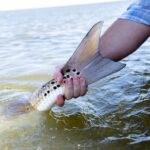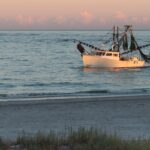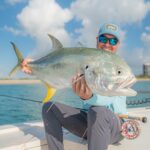New Alabama Redfish Regs: Conservation Momentum Grows
Photo Credit: Graham Tayloe Big Win for Redfish in Alabama Huge news from the Marine
Good news with menhaden, but a storm brewing with striped bass
By Capt. John McMurray
The Atlantic States Marine Fisheries Commission met August 3 to August 6 to address a number of issues. As is usually the case, we’ll try and boil it down to just the stuff you’re most likely interested in.
Let’s start with menhaden.

Menhaden
The Menhaden Management Board met, in two different sessions over two days, to discuss the implementation of “Ecosystem Reference Points” (ERPs).
ERPs are fishing mortality and biomass targets (and thresholds) that would theoretically maintain predator populations (e.g., striped bass, bluefish, weakfish, etc.) at healthy levels.
The end result – after literally decades of advocacy by angling and environmental groups – was the Board’s unanimous decision to manage menhaden in the context of their importance as prey.
The ERPs the Board chose are based on menhaden’s relationship solely to striped bass. Unsurprisingly, the model showed that striped bass was the species most affected by menhaden abundance, which does match up to what those of us who spend a lot of time on the water observe.
Because striped bass are so sensitive to the model, the multispecies stock assessment concluded that an ERP target and threshold that sustained striped bass at their target level would likely be beneficial for other predators.
Yes, this is big news. And it’s the culmination of a long fight. But in practical terms, what does it mean?
The truth is, not much… at least not in the short term. Total harvest will likely not change much, if at all.
The single species stock assessment for menhaden – which the Board had used for management prior to the August decision to adopt ERPs – showed the stock to be very abundant, and would have allowed a much greater harvest than the Board had been allowing. To its credit, the Board was conservative with its harvest level, understanding the species’ role in the ecosystem and that ERPs were in the works. Not to mention the public would not have reacted well to a 40% increase for essentially one company’s benefit.
In the end, that cautious management approach proved to be in line with the latest science. Theoretically, the rate at which industry is fishing menhaden right now is a good place to be in regard to maintaining striped bass at their biomass target.
It’s possible that there may even be room for a small increase in harvest. And I’m guessing that’s what some states will be pushing for in October when the Board decides 2021 harvest levels. I suppose we’ll see how that unfolds.
Regardless, what this decision did, in the short term anyway, is prevent the yearly push and subsequent debate in October regarding whether or not we should give industry a significant increase, because, after all, the science said we could. And THAT is a big deal. While it won’t give us a reduction in industry harvest, it should indeed prevent a significant increase.
Overall, this is a BIG first step in ecosystem management. It took the Board a LONG time to get here, but there will undoubtedly be a LOT more work to do to keep things moving in the right directions.
Stay tuned.
Striped Bass
First thing on the agenda was to review a striped bass working group report.
Working Group
A “working group” composed of Striped Bass Management Board commissioners was formed in the spring and met several times to discuss striped bass management, where the problems were and where it could be changed/improved. The intent was to provide guidance for the possible initiation of a new amendment to the management plan, which could completely restructure how we currently manage striped bass.
The conclusions of that working group were not exactly encouraging to those of us who run businesses that depend not necessarily on how many fish we can kill, but on general striped bass abundance and availability.
Themes that emerged were the need for “management stability” and “regulatory consistency,” and avoiding “knee-jerk” reactions when the stock fluctuates. These views were particularly confusing given there have only been two management changes in the last 17 years when management triggers were met: one when an assessment said the stock was clearly headed downhill, and one when it became overfished. That hardly seems like a “knee-jerk” reaction.
Another prominent theme that emerged was the desire for more “flexibility” in management. To put it simply that means flexibility to not do anything when the science is clear that the stock is trending downward. It means flexibility to exceed fishing mortality reference points, or to go under the biomass threshold without taking corrective action. In short, the sort of flexibility the working group seems to be suggesting would allow overfishing due to political pressure. Hard to see “flexibility” in this context any other way. We should note here that the Board has the power to disregard management triggers in any case, and they certainly have done that on more than one occasion.
It’s pretty clear to us that this is NOT what the bulk of recreational stakeholders want. But the working group seemed tone-deaf to the 90% of this fishery that’s purely recreational and the fact that 90% of the striped bass caught are released.
Discard Mortality
And that leads us to discard mortality. There was a definitive focus within the working group on the need to address recreational discards (those fish that die after release).
There was a lot of hemming and hawing about how terrible and wasteful recreational discards are. Particularly interesting was the statement made by a representative of one of the biggest small-net fisheries on the east coast about witnessing all the “floaters” amongst a recreational fleet, when it’s pretty clear to anyone who fishes Montauk etc., that the ONLY real floater events are when squid boats roll though the grounds. There have been exceptionally large striped bass bycatch/discards in that fishery.
But it is indeed true that recreational discards account for way more – almost 50% of total mortality. That is of course to be expected in any fishery that is largely recreational and largely catch and release. There seems to be some sort of disconnect with the Board on what that means though.
There were some comments about how that’s the result of constraining size and bag limits, with the presumption that if we liberalize regulations, we could reduce discards. But that makes NO sense. Yes, the more constraining regulations are, the more you increase discards. However, that increase is a small fraction of the increase in total fishing mortality that would result from liberalizing size and bag limits.
So what’s the solution? How can the Board address discards? Well, there were all sorts of comments about gear requirements (e.g., circle hooks), and education on release techniques that maximize survival, while the right thing to do, it won’t change discard estimates, because those factors have not been incorporated into the calculations yet. Currently, the only measure that would possibly work are time and area closures, and even those are difficult when it comes to the numbers. Regardless, that is not an option the public is likely to swallow, nor is it one in which we would likely support.
The truth is that discards are just part of this fishery. They are part of every “sport” fishery that is valued more for the experience rather than filling coolers (e.g., bonefish, tarpon, permit, steelhead etc.). But that is NOT a concept the Commission has been able to understand. There are still comments from certain Board members that this is largely a meat fishery, despite broad evidence to the contrary.
In the end, the Board passed a motion to direct staff to take a closer look at recreational discards, although it was not clear what exactly that meant.
Editorializing for a minute, this fixation on discards irrational, and appears to be more of a red herring than anything else. We’ll see how this all shakes out, but I’m guessing the Board will hem and haw more over this for the next two years, and in the end, there will be no real measure that will address it. Eventually, it’ll just need to be accepted as a part of the fishery.
But let’s move on.
Tabled Accountability Motion
At the February meeting, there was a motion put forth to require those states who chose conservation equivalency measures to achieve Addendum VI reductions – instead of the recommended coastwide measures – to be accountable should those states not achieve the required reduction.
This was a common-sense request since it had become clear that a few states were using the conservation equivalency program to get more fish for their state, at the expense of other states. And it was clear that in the past, some states’ conservation-equivalent measures had not achieved the reduction they were supposed to.
Yes, we do understand that availability (e.g., super-abundant year classes) drive up fishing mortality in some areas (e.g., the Chesapeake Bay), but the proposed motion was in no way unreasonable: If a state was below its predicted target reduction (i.e., was going to kill too many fish), the Board could consider making a state change their measures for the next fishing year to achieve the target reduction.
In other words, it would be up to the state to make the case on why its reduction wasn’t met and then up to the Board to decide whether or not it needed to change regulations the following year.
Regardless, the motion was shot down pretty quickly given the COVID pandemic-caused dearth of recreational data in 2020, and the motion was specific to Addendum VI reductions. I mean, how can we hold a state accountable if there was no real data showing an overage?
Tabled motion to initiate a new amendment
Let’s move on to the really important stuff.
At one of last year’s Striped Bass Board meetings, there was a motion to initiate Amendment VII to the striped bass management plan. That amendment would presumably address the possibility of changing the goals and objectives of the management plan, take a look at new fishing mortality and biomass reference points, possibly tweak the management triggers for action, address rebuilding, and area‐specific management (i.e. coastal vs. Chesapeake). See our blog from a few weeks ago that gets into the specifics.
That motion was tabled, because we were still working our way through an addendum to address overfishing.
That tabled motion was considered at this meeting.
There was a robust discussion about timing, and the appropriateness of moving forward with an amendment during the COVID pandemic. It was pointed out that recreational surveying (MRIP) was severely curtailed in the spring and that there was really no data to determine how new slot limit regulations were preforming. As a result, some pointed out that it was premature to begin a new amendment when we were unsure of what was currently happening on the water. Also, the idea of holding a public comment period when public hearings likely aren’t going to happen is problematic. Online hearings could be chaotic and could skew public sentiment. In general, it seemed like a good idea to just wait it out, and to keep the motion tabled.
To our surprise, however, a motion to initiate an Amendment did pass. But the way it was framed was to merely put the following issues out to the public for feedback: 1) Fishery Goals and Objectives; 2) Stock Rebuilding/Timeframe; 3) Management Triggers; 4) Biological Reference Points; 5) Regional Management (Recreational Measures, Coastal and Producer Areas, Regional Reference Points); 6) Recreational Dead Discards; 7) Conservation Equivalency; 8) Recreational Accountability; and 9) Coastal Commercial Quota Allocation.
All of these topics will be presented in a Public Information Document to solicit stakeholder comment, with a focus on prioritizing the importance of each topic for continued development and inclusion in the Amendment.
And that’s where we come in.
It will be damn important to get a good turnout during this public engagement process, which begins this fall. Managers need to know and understand the real dynamics of this fishery. If all we have are the usual suspects clamoring for more dead fish, well, that’s what we’ll likely end up with.
Stay tuned on information on the where and when. Presumably most if not all of the hearings will be virtual. We’ll be sure you have the info on how to engage.
Bluefish
Just a few quick sentences on where we are with the bluefish reallocation amendment. On the last day the Council and Commission met to refine draft alternatives. They mostly have to do with transfer approaches, recreational/commercial allocation as well as state by state allocation. Of some significance is that the Board/Council voted to remove recreational sector allocation (charter vs. recreational) from the document.
We’ve written some about how bluefish could be a good example of a fishery that’s managed for opportunity/fish-in-the-water, given it’s largely a catch and release fishery. While that was certainly discussed during scoping, and actually made it to the list of considerations for the Amendment, in the form of catch-based landings rather than harvest, unsurprisingly, it ended up dead on arrival.
An issue that remains with bluefish is that what we don’t kill can still be transferred to the commercial side (when the stock isn’t overfished, that is), which sort of defeats the purpose of releasing fish for conservation reasons. But given the new recreational effort estimates we don’t see any transfers being made any time soon.
The Board and Council will likely approve a final range of alternatives during their December joint meeting, with a Draft Amendment expected to be considered for release for public comment by February 2021.
On the Summer Flounder, Scup and Black Seabass front, there’s a Recreational Reform Initiative underway that will presumably address recreational stability and flexibility for all four jointly managed fisheries, including bluefish. Staff provided information on what type of management action, if any, would be necessary to implement the ideas discussed. This item is not really ripe for public consumption yet, but we’ll keep an eye on how things develop.
That’s all for this meeting. Stay tuned and we’ll keep you all in the loop.
Photo Credit: Graham Tayloe Big Win for Redfish in Alabama Huge news from the Marine

Feature Photo: Carter Abramson | Simms Fishing at the Fisheries Science Symposium We have more

Each year, hundreds of millions of fish are killed as collateral damage from large-scale, inshore

Feature Photo Credit: Scientific Anglers Team At the heart of the Jack Project is a
We rely on our members and donations to keep fighting for a sustainable tomorrow in marine conservation.
GIVE THE GIFT OF FISHERIES CONSERVATION THIS HOLIDAY SEASON. SHOP ASGA GOODS THAT FUND FISHERIES RESEARCH & ADVOCACY CAMPAIGNS
JOIN ASGA IN CALLING FOR CRITICAL MANAGEMENT ACTION AFTER YEARS OF SPAWN FAILURES & POOR MANAGEMENT.
By using this website, you agree to our use of cookies. We use cookies to provide you with a great experience and to help our website run effectively. To learn more, please review our privacy policy.
3 Responses
Thanks for the synopsis!
A lot of important moving parts here—thank you for the rundown.